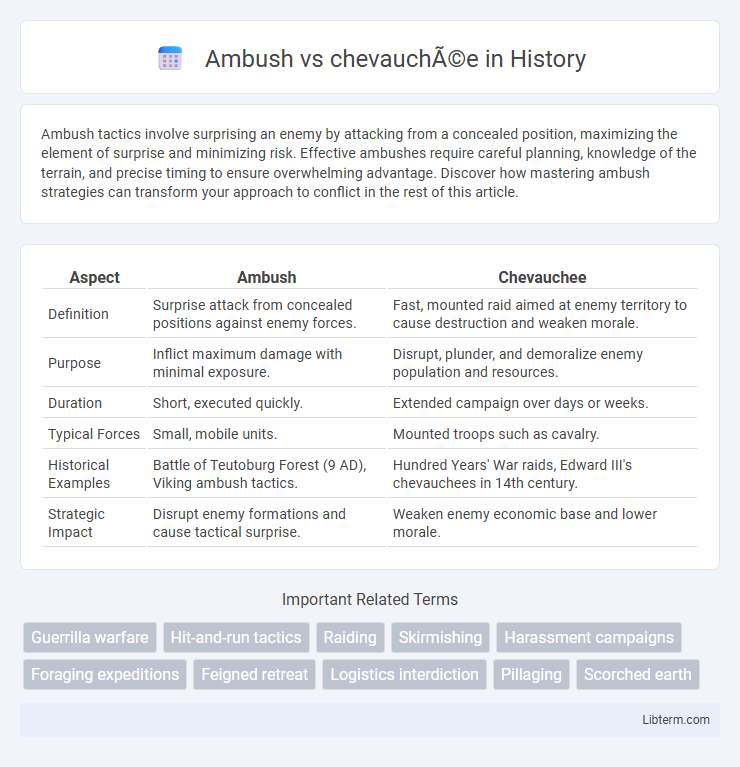Ambush tactics involve surprising an enemy by attacking from a concealed position, maximizing the element of surprise and minimizing risk. Effective ambushes require careful planning, knowledge of the terrain, and precise timing to ensure overwhelming advantage. Discover how mastering ambush strategies can transform your approach to conflict in the rest of this article.
Table of Comparison
| Aspect | Ambush | Chevauchee |
|---|---|---|
| Definition | Surprise attack from concealed positions against enemy forces. | Fast, mounted raid aimed at enemy territory to cause destruction and weaken morale. |
| Purpose | Inflict maximum damage with minimal exposure. | Disrupt, plunder, and demoralize enemy population and resources. |
| Duration | Short, executed quickly. | Extended campaign over days or weeks. |
| Typical Forces | Small, mobile units. | Mounted troops such as cavalry. |
| Historical Examples | Battle of Teutoburg Forest (9 AD), Viking ambush tactics. | Hundred Years' War raids, Edward III's chevauchees in 14th century. |
| Strategic Impact | Disrupt enemy formations and cause tactical surprise. | Weaken enemy economic base and lower morale. |
Introduction to Medieval Warfare Tactics
Ambush and chevauchee were distinct tactics in medieval warfare with unique strategic purposes. Ambush involved surprise attacks designed to catch enemies off guard, leveraging terrain and stealth to maximize damage quickly. Chevauchee focused on rapid mounted raids to disrupt the enemy's economy and morale by destroying crops, supplies, and villages across large areas.
Defining Ambush and Chevauchée
An ambush is a military tactic involving a surprise attack from a concealed position, aimed at quickly overwhelming the enemy with minimal exposure. Chevauchee refers to a raiding strategy used primarily in medieval warfare, characterized by fast-moving cavalry that ravages enemy territory to disrupt supply lines and economic resources. Both tactics emphasize mobility and psychological impact but differ in execution: ambush relies on stealth and surprise, while chevauchee focuses on sustained territorial devastation.
Historical Origins of Both Strategies
Ambush tactics trace back to ancient warfare, prominently used by civilizations like the Greeks and Romans to exploit surprise and terrain advantages during battles. Chevauchee originated in the medieval period, especially employed during the Hundred Years' War by English forces as a strategy of mounted raiding to disrupt enemy economies and demoralize populations. Both strategies reflect distinct historical contexts: ambush emphasizes sudden, localized attacks while chevauchee represents systematic, large-scale mounted campaigns for territorial and economic damage.
Key Objectives: Ambush vs Chevauchée
The key objective of an ambush is to surprise and overwhelm the enemy force by attacking from a concealed position, aiming for quick, decisive damage and disruption. In contrast, a chevauchee focuses on a rapid, large-scale mounted raid designed to devastate enemy territory, destroy resources, and weaken morale over a wide area. Ambushes prioritize tactical advantage and immediate combat effectiveness, while chevauchees emphasize strategic disruption and long-term attrition.
Planning and Execution Differences
Ambush tactics require meticulous planning of location, timing, and target selection to maximize surprise and minimize exposure, often involving stealth and terrain advantage for a sudden, concentrated attack. Chevauchee emphasizes rapid, wide-ranging movement to disrupt enemy supply lines and morale, prioritizing speed and endurance over concealment in its execution. The ambush hinges on precise coordination and patience before striking, while the chevauchee demands relentless momentum and adaptability during the raid.
Impact on Enemy Forces and Territories
An ambush disrupts enemy forces by inflicting sudden, concentrated casualties and creating psychological shock, effectively immobilizing troops and degrading morale without significant territorial change. A chevauchee targets the enemy's territory through systematic raids, destroying infrastructure, supplies, and resources to undermine the opponent's economic stability and civilian support. Both strategies weaken enemy capabilities, but ambushes primarily affect troop effectiveness, while chevauchees strategically erode control over contested regions.
Notable Examples in Medieval History
The Battle of Hastings in 1066 exemplifies a decisive ambush where William the Conqueror's forces strategically concealed themselves before overwhelming King Harold's army. In contrast, the chevauchee tactics of the Hundred Years' War, notably Edward III's 1346 campaign across northern France, involved widespread raiding and destruction to demoralize and destabilize enemy territories. These notable examples highlight the ambush's emphasis on surprise and localized engagement versus the chevauchee's broader strategy of economic devastation and psychological warfare.
Advantages and Disadvantages
An ambush leverages surprise and terrain advantage to inflict maximum damage with minimal losses, ideal for smaller, agile forces but risks heavy casualties if detected prematurely. A chevauchee emphasizes rapid, scorched-earth raids to disrupt enemy supply lines and morale, advantageous for weakening opponents over wide areas but vulnerable to counterattacks and supply issues. Choosing between ambush and chevauchee depends on tactical goals, force composition, and environmental factors.
Evolution and Legacy in Military Strategy
The evolution of ambush tactics introduced surprise and concealment as core elements, shaping guerrilla warfare and small-unit engagements throughout history. Chevauchee, a strategy centered on rapid, mounted raids to disrupt enemy resources and morale, influenced medieval and early modern campaign designs, emphasizing mobility and economic warfare. Their legacy endures in modern military strategy through combined-arms tactics and asymmetrical warfare doctrines that prioritize speed, deception, and resource denial.
Conclusion: Strategic Lessons Learned
Ambush tactics emphasize surprise and terrain advantage to disrupt enemy forces quickly, while chevauchee relies on sustained raids to weaken the enemy's resources and morale over time. Strategic lessons highlight the importance of adaptability, with ambushes favoring concentrated force at critical points and chevauchee demanding logistical planning and harassment to erode enemy stability. Effective commanders integrate both approaches to balance immediate tactical gains with long-term operational pressure.
Ambush Infographic

 libterm.com
libterm.com